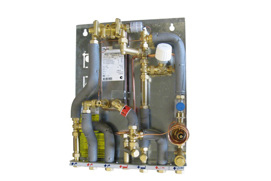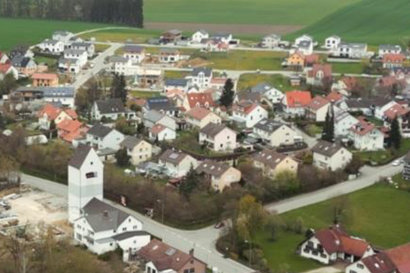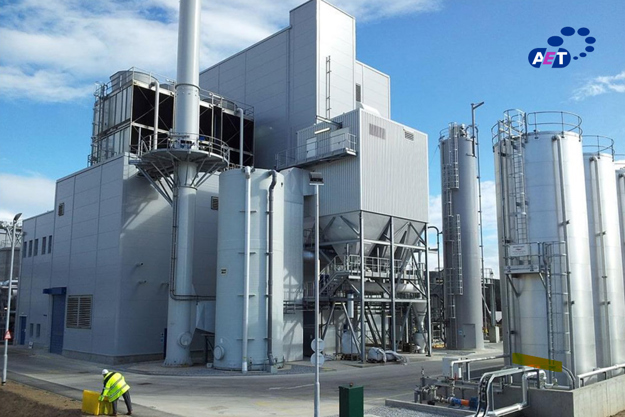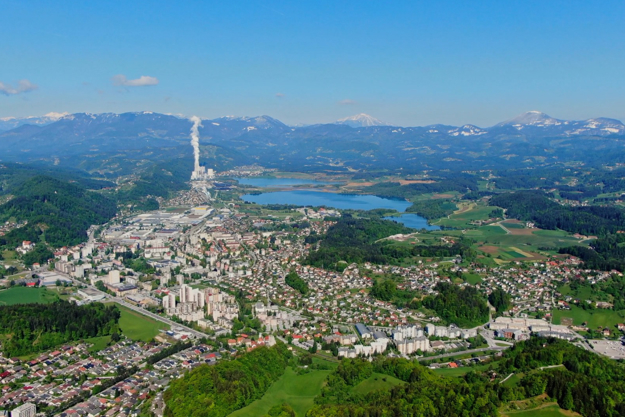Conventional heating systems in single-family houses and apartment buildings consist of a central heat source and central DHW production. Today, renovated or new buildings are obliged to make at least partial use of renewable energy sources. All buildings must comply with strict DHW hygiene regulations.
In nearly all cases, it makes financial sense to heat multiple apartments, buildings or houses via a central system rather than individually. Modern central heating systems can use buffer tanks to combine different energy sources.
Buildings with decentralized DHW production need only three rather than the usual five supply lines to provide hygienically safe drinking water. If the volume of water held between the water heater and the taps is less than 3 liters, no regular hygienic testing is required.
Each building and apartment has a directly connected substation or flat station with integrated production of domestic hot water. Single or multiple heating circuits (e.g. radiator, floor heating system) are supplied with heated water from the central heat source.
Features and benefits
Domestic hot water is produced on demand, without storing
Heating systems can combine different energy sources
Product range
-
if (isSmallPicture) {


 Direct heating with mixing loop and domestic hot water
Direct heating with mixing loop and domestic hot waterSubstations for direct heating have no heat exchanger separating the primary flow from the secondary flow. Therefore the supply from the network or the central oil-/gas boiler will flow directly into the network in each flat. Direct substations are recommended for maximum PN10 or PN6 networks.
-
if (isSmallPicture) {


 Indirect or direct heating and domestic hot water cylinder
Indirect or direct heating and domestic hot water cylinderSubstations for indirect heating have a heat exchanger separating the primary flow from the secondary flow. Indirect substations are recommended for PN16 networks and higher pressure classes. Substations for direct heating have no heat exchanger separating the primary flow from the secondary flow and are recommended for maximum PN10 or PN6 networks. The domestic hot water is heated in a cylinder by the district heating water flow in a coil within the cylinder.
-
if (isSmallPicture) {


 Direct heating and domestic hot water
Direct heating and domestic hot waterSubstations for direct heating have no heat exchanger separating the primary flow from the secondary flow. Therefore the supply from the network or the central oil-/gas boiler will flow directly into the network in each flat. Direct substations are recommended for maximum PN10 or PN6 networks.
-
if (isSmallPicture) {


 DSP MOD@ substation
DSP MOD@ substationDSP stands for ‘Danfoss Substation Prefabricated’, highlighting the fact that you get a substation that is easy to install and that complies with 90% of the typical district heating network technical connection requirements. MOD@ stands for ‘modular and digital’, meaning you get a substation that’s flexible, easy to configure and works seamlessly with our digital district heating network product portfolio.
Documents
| Type | Name | Language | Valid for | Updated | Download | File type |
|---|---|---|---|---|---|---|
| Brochure | Specifying the right district heating substation makes commercial sense | Ukrainian | Ukraine | 18 Sep, 2015 | 2.2 MB | |
| Brochure | Specifying the right district heating substation makes commercial sense | Croatian | Croatia | 06 Aug, 2015 | 2.5 MB | |
| Brochure | Specifying the right district heating substation makes commercial sense | Romanian, Moldavian, Moldovan | Romania | 29 Aug, 2015 | 2.3 MB | |
| Brochure | Specifying the right district heating substation makes commercial sense | English | Multiple | 05 Mar, 2015 | 2.4 MB | |
| Brochure | Specifying the right district heating substation makes commercial sense | Bulgarian | Bulgaria | 31 Jul, 2015 | 11.3 MB | |
| Brochure | Specifying the right district heating substation makes commercial sense | Slovak | Slovakia | 21 Jul, 2015 | 2.4 MB | |
| Brochure | Specifying the right district heating substation makes commercial sense | German | Multiple | 16 Mar, 2020 | 3.1 MB | |
| Brochure | Specifying the right district heating substation makes commercial sense | Slovenian | Slovenia | 21 Jul, 2015 | 5.2 MB |
Tools and apps
Case stories
-
if (isSmallPicture) {


 Roll-out in 50,000 housing units: enercity AG optimizes district heating supply with Leanheat® Building
Roll-out in 50,000 housing units: enercity AG optimizes district heating supply with Leanheat® BuildingThe AI-powered software Leanheat® Building helped Hanover’s district heating utility systematically integrate the buildings side of the network and achieve a 5-10% reduction in energy consumption and a 20% reduction in peak loads.
-
if (isSmallPicture) {


 Successful transition from oil boilers to a local heating network in Eurasburg
Successful transition from oil boilers to a local heating network in EurasburgIn the Wittelsbacher Land near Augsburg the local network in Eurasburg supplies heat to 80 buildings using a wood chip heating system. Danfoss’ substations ensure efficient heating in all building types, and its modern SCADA solution enables remote system monitoring and management.
-
if (isSmallPicture) {


 DrivePro® Lifecycle Services secure maximum uptime for Rothes CoRDe
DrivePro® Lifecycle Services secure maximum uptime for Rothes CoRDeSCOTLAND: The Rothes CoRDe plant, a biomass-fired combined heat and power (CHP) plant, ensured maximum uptime thanks to several DrivePro® Lifecycle Services.
-
if (isSmallPicture) {


 Willhem AB and Danfoss AB takes the energy optimization in residential properties to the next level
Willhem AB and Danfoss AB takes the energy optimization in residential properties to the next levelGOTHENBURG, SWEDEN & HELSINKI, FINLAND – This heating season, European energy prices are expected to rise to record levels. One of the largest Swedish professional building owners, Willhem AB, has taken a proactive approach to cutting costs and reducing greenhouse gas emissions. Willhem has signed an agreement with Danfoss to implement the Leanheat Building software starting with 6,500 apartments.
-
if (isSmallPicture) {


 Pipe tracing in 600 Suzhou apartments China
Pipe tracing in 600 Suzhou apartments ChinaSuzhou city was founded in 500 BC. is nowadays a major city located in the south-eastern Jiangsu Province of East China, about 100 km (62 mi) northwest of Shanghai. It is a big economic center and local point of trade and commerce, and the second largest city in the province, after its capital Nanjing.
-
if (isSmallPicture) {


 Improved hydronic balancing of the district heating network in Slovenia
Improved hydronic balancing of the district heating network in SloveniaThe Saleska Valley district heating network is the second largest network in Slovenia, dating back to 1959. Since then, the demands have changed significantly and have challenged the hydronic balancing of the system which was optimized with new intelligent controllers Virtus.































